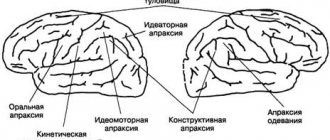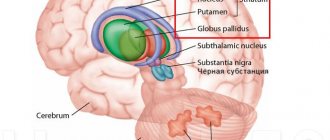Among the huge number of different diseases, there is one that causes a feeling of shame and frustration. This is a head tremor.
Shaking movements of the head are very noticeable to others; a person with such symptoms tries to avoid communication with other people.
Is there really nothing that can be done about this? To answer this question you need to understand the nature of this disease.
Attention! Tremor is most often just a symptom of some disease. Appears at any age. One of the main properties is the ability to progress over time. Intensifies due to fatigue, strong emotions, and pathology of the nervous system.
Shakes for various reasons...
Since the causes of this disease are different, it is divided into different types. Features of the main types of tremor:
- The occurrence of dystonic tremor mainly occurs in patients with generalized or focal dystonia and appears due to dystonic posture. May intensify with resistance to tonic hyperkinesis.
- The causes of essential head tremor are often hereditary. In 25% of cases, trembling is also accompanied by impairment in writing and a slight degree of curvature of the neck. Causing factors: stress, nervous disorders, worries.
- Cerebellar . One side of the brain is affected. Usually does not cause difficulties in treatment. Along with trembling, there is a lack of coordination of movements. Alcoholism and uncontrolled use of medications provoke the occurrence of this type. Diseases such as stroke, tumors, sclerosis can cause symptoms.
- Neuropathic tremor. Any disease of the nervous system can provoke the occurrence of this type. It responds well to treatment. Usually, sedatives are prescribed by a doctor; consultations with a psychologist will also not be superfluous.
- Rubral . A combination of several types. Includes all possible manifestations of head tremors associated with damage to the midbrain. A doctor can help get rid of the disease only after a serious medical examination. Treatment often raises the question of neurosurgical intervention in certain parts of the brain. Complex and requiring long and carefully selected treatment.
- Pathological tremor appears against the background of a hereditary disease associated with diseases of the nervous system or acquired as a result of traumatic brain injury, stroke.
- Benign is a condition when there is no visible reason why the head is shaking. Most often it can appear during the transition period. This phenomenon intensifies with nervous excitement with the use of alcohol.
- Intentional is caused by dysfunction of the cerebellum. Symptoms worsen when walking and running. For more effective treatment, surgery is required.
- Physiological tremor. Brief shaking of the head with excitement or fear. Head shaking is almost imperceptible and does not require serious treatment. After consultation with a doctor, sedatives and baths are usually prescribed.
- Parkinsonian appears in Parkinson's disease in older people. It intensifies during rest and disappears during sleep. Can't be cured. Doctors prescribe special medications to reduce the symptoms of the disease.
Tremor is a serious condition that requires immediate treatment. The disease causes musculoskeletal disorders, speech and writing disorders, neck curvature, and limits the range of movements. Perhaps the appearance of severe headaches and pain in the neck.
The disease signals that there are serious malfunctions in the body that threaten serious problems: loss of speech, inability to move independently, severe forms of disability, death.
When the head begins to tremble or shake due to excitement or severe psychological stress, there is no big reason for concern. By consulting a neurologist, you can quickly solve this problem. But when your head shakes constantly, you should sound the alarm. Serious medical treatment is required.
In addition to the causes of tremor listed above, the disease can be caused by changes in the functioning of the thyroid gland, liver and lung diseases, as well as all head injuries.
IMPORTANT! Any type of tremor will only intensify the strongest emotional experience.
Complications of head tremors
With this pathology, the arteries of the brain are greatly compressed. He has a poor blood supply. This pathological condition poses a danger to the blood vessels of the brain. Intervertebral discs bulge, cartilage becomes deformed, weakens, and cracks due to advanced disease. Spasmodic reactions of the body are characteristic, as the vertebrae are displaced.
Bone osteophytes grow on these structures. Extremely painful pinching of nerve fibers becomes a consequence of this pathological process. The risk of tumors increases. This is the worst case of the disease. Aesthetically, tremor is extremely unpleasant for others.
The emotional and psychological state of the patient is seriously disturbed. He has difficulties adapting to society. Often it is impossible to engage in professional activities.
Difficulties, goals and methods of therapy
The treatment is going to be long, you need to get ready for it. First of all, you should make an appointment with a neurologist.
The key to successful treatment will be a complete and truthful description of the symptoms of the disease.
The doctor may ask several questions, you need to answer them as completely as possible:
- In what situations does your head begin to shake or tremble?
- When did this appear?
- Were there any illnesses caused by head trauma?
- Is your neck bothering you?
- What health problems do you have?
Think through your answers to the questions in advance. Depending on the situation and the reason why the head is shaking, the doctor prescribes treatment.
What does medicine offer?
Traditional therapy methods:
- With the help of medications prescribed by a doctor. First of all, medications are prescribed that have a calming effect on the general emotional state of a person.
- If the tremor is caused by problems with the neck, then the help of a chiropractor will be helpful.
- You may need to make an appointment with a good psychologist who can stabilize your emotional state, reduce nervousness, and have a calming effect on the entire body.
- You can search the Internet for relaxation and meditation techniques . A state of peace and tranquility will promote healing.
- Any treatment methods to enhance the positive effect should be combined with medications .
- Take up physical exercise. This could be fitness or dance sports .
- Sign up for a yoga class.
- Surgery . For some types of tremors, electrodes are implanted into the brain organs.
Grandmothers' experience
Traditional medicine plays an important role in the treatment of tremor. Some useful recipes:
- Take 4.5 tbsp. oats, pour 1.5 liters. boiling water Place over moderate heat and simmer for one hour. Then close the lid and let it brew until the next day. The next day, strain and drink. Has a calming effect.
- Dried tansy flowers , preferably the flowers rather than the stem and leaves, chew for 10-15 minutes without swallowing.
- Warm baths with chamomile, St. John's wort, wormwood, linden, and valerian will have a beneficial effect. In order to prepare a bath you need to take 10 tbsp. one of the listed herbs, or several different ones. Take the grass dry, pour in boiling water, about half a liter, let it brew under the lid for about 30 minutes. Then filter the mixture and pour it into the bath. The bath can be taken for 15-20 minutes, preferably before bed.
Why does your head shake and how to treat it:
Having chronic pain
If you constantly suffer from pain in your neck or back, and it radiates to your arm, leg, or interferes with your body movements, you should not wait for it to go away on its own. Pain with numbness of body parts is especially dangerous. The reason for visiting a neurologist should be pain in the lower back, thoracic spine or neck, which causes dizziness, lumbago, general malaise or drowsiness. Also a reason for immediate consultation is pain in the lumbar region with problems with urination or defecation.
Avoid risks
First of all, you need to lead a healthy lifestyle. No alcohol, drugs, or smoking. Follow a daily routine, try to sleep at least 9 hours.
Try to get as many pleasant emotions as possible. Contact a specialist at the slightest suspicion of illness.
There is no need to be ashamed of head tremors and try to hide this condition, it won’t work anyway. Don't hide from the problem, thinking that everything will go away on its own, it won't happen.
Sound the alarm at the slightest symptoms, consult a doctor and everything can still be improved for the better. Take care of yourself and be healthy!
Head tremor with cervical osteochondrosis
Osteochondrosis of the cervical spine, in addition to other various symptoms, is manifested by head tremor. With the development of a disease of the spine, which is based on degeneration of bone and cartilage tissue, the position of the cervical vertebrae changes, the nerve endings are pinched and the blood supply to the head deteriorates. Oxygen starvation of the brain begins.
The progression of tremor against the background of cervical osteochondrosis is accompanied by headache, tinnitus, and increased blood pressure. The development of osteochondrosis increases head tremor along with other manifestations of the disease. Therefore, you should not ignore the signs of the disease. It is in the interests of the patient to promptly contact a specialist for examination and treatment.
Treatment
Conservative therapy
The completeness and effectiveness of treatment for head tremor depends on eliminating the cause, but since the etiology of many diseases remains incompletely understood, the main directions of therapy remain symptomatic and pathogenetic. The situation is complicated by the fact that head tremors, unlike those localized in the hands, are less amenable to pharmacotherapy. The main groups of medications include:
- Beta blockers.
Non-selective β-blockers (propranolol, nadolol, sotalol) have shown their effectiveness in essential and other types of tremor, which is due to the inhibition of sympathetic influences. Targeted drugs (atenolol, metoprolol) can also be used. - Anticonvulsants.
A negative or insufficient response to β-blockers requires the use of anticonvulsants. Primidone, gabapentin, and topiramate have the ability to suppress the generation of tremor. Temporary improvement can be observed under the influence of clonazepam, alprazolam. - Antiparkinsonian.
Treatment of parkinsonian head tremor is usually carried out with levodopa, which, if ineffective, is treated with dopamine receptor agonists (pramipexole) or amantadine. Static tremors respond better to such therapy than action tremors.
Before actively treating head tremor, pay attention to the exclusion of stimulants from the diet (coffee, strong tea), and the abolition of certain medications. In addition to pharmacotherapy, botulinum therapy is considered an important area. Most often, injections are performed to treat dystonic head tremor. Physical methods include kinesiotherapy, wearing cervical collars, exercise therapy and massage.
Diagnostics
To determine the cause of involuntary head movements, the doctor may prescribe the following types of examinations:
- magnetic resonance imaging (MRI) of the brain to identify vascular and organic lesions;
MRI of the head. What does normal show? - emission computed tomography of the brain (SPECT);
- pharmacological research (alcohol test and others).
Causes of pathology
In most cases, the disease is a consequence of exhaustion or overwork, or a stressful situation. Trembling in the head can be caused by taking certain medications or by heredity. The development of tremor is also caused by changes in the body due to:
- multiple sclerosis;
- poisoning with salts of heavy metals;
- hyperthyroidism;
- cervical osteochondrosis;
- pathologies of the respiratory system, liver or kidneys;
- damage to the central nervous system, midbrain;
- alcohol or drug addiction.
In adolescents, the disease can occur due to excessive mental or emotional stress.











